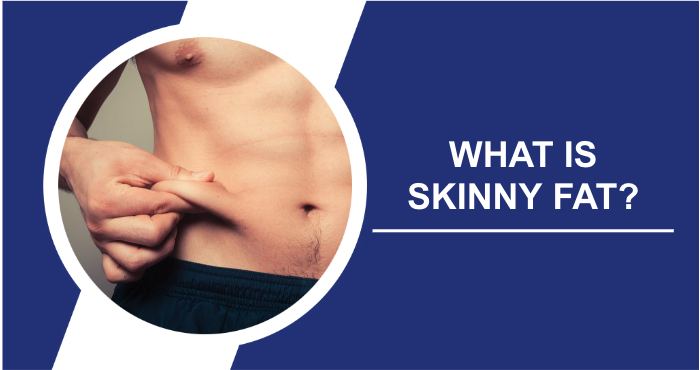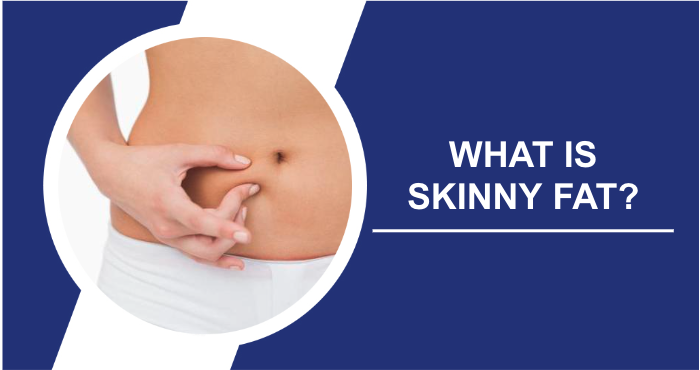Have you come across the expression ” fat” in discussions? What exactly does it imply when someone describes you as ” fat”? It’s a situation that numerous individuals encounter, where your physical appearance doesn’t fully reflect whats happening internally in your body.
The common belief is that if you have body fat, your BMI (Body Mass Index) will be high, indicating poor health. Is a slim and lean physique always a sign of good health?
This piece delves into the idea of ‘thin fat’ and its true implications. It’s crucial to grasp that possessing a ” fat” physique doesn’t always equate to poor health. Nevertheless the positive aspect is that you can enhance your body composition even if your BMI leans, towards the end.
So What Exactly Is Meant By "Skinny Fat"? From a BMI perspective, you may appear to have a normal weight for your height. People might assume you're reasonably healthy because of your weight and slim appearance. However, being "skinny fat" means that you have a low amount of muscle mass in your body and a noticeable amount of excess body fat, despite your slim appearance.
At What Point Are You Overweight?
Determining if you’re carrying weight is akin to piecing together a puzzle and it differs for each individual. It’s not just about the digits on a scale or adhering to a BMI chart; it’s, about grasping the unique narrative of your body.
It’s that moment when your jeans fit tighter around your curves, when you feel a little less like yourself and realise that taking care of yourself should be at the forefront of your routine. It’s when your body quietly whispers, “Hey, maybe it’s time to choose a path. Being overweight is when you decide to listen to your bodys narrative and embark on a journey towards self-love and overall wellbeing.
Why Is Being Overweight Bad?
Carrying weight doesn’t just refer to appearance; it’s more about how it can affect our well being. When we have weight it can strain our joints and lead to difficulties, in movement. Additionally it raises the chances of developing health issues like diabetes, heart disease and high blood pressure.
But it’s important to remember that our overall health isn’t just determined by a number on a scale. What really matters is how we feel and function in our bodies. Rather than focusing solely on the idea that being overweight is inherently bad, we can shift our attention to promoting overall wellbeing and making choices that prioritise both our physical and emotional health.
What Is Skinny Fat?

Picture this scenario; You see someone who appears slim and fit. In reality they have a notable amount of hidden visceral fat in their body. The term ” fat” is used to describe individuals, with low muscle mass density who also harbor body fat even though they may seem lean outwardly.
What Does Skinny Fat Look Like?
When looking at this condition from a BMI perspective, it may appear that your weight is proportionate to your height, giving an impression of normality. To an outsider, your average weight and lean physique may suggest health. However, beneath the surface there is an amount of body fat that needs attention.
Medically referred to as MONW (Metabolically Obese Normal Weight) this situation occurs when visceral fat builds up even though someone looks slender externally. Lets discuss the fat that tends to gather near our organs, which can be worrisome for individuals who seem slim but might be harboring extra weight in less obvious spots. It’s crucial for them to stay informed, about health concerns.
Now here’s the part about visceral fat. In small amounts, it actually plays a positive role. It acts as a shield for our organs and can even act as a backup energy source when needed. However, problems arise when we start to accumulate subcutaneous fat. Imagine having a cushion around your abdomen, especially around your intestines, gallbladder and pancreas. This is a sign of obesity. It increases the risk of future health complications.
What Causes The Phenomenon Of Being Skinny Fat?
When someone is called ” fat ” it often means they have more body fat and less muscle mass. Several factors can lead to this situation, such as
Accumulation Of Visceral Fat
Having excess fat in the body, especially around major organs, can pose health risks. It’s important for people with belly fat to prioritise efforts to reduce it. One way to identify fat is to assess the abdominal area or measure the waist and abdomen. Another useful measurement is the waist-to-hip ratio. Measure your waist and hips and then divide your waist measurement by your hip measurement.
This measurement provides insight into the distribution of fat in your body and your general well being. If your ratio exceeds 0.85 it suggests the presence of some body fat. For men aiming to safeguard their health a ratio above one signifies a level of body fat. Yet, for an evaluation of your visceral fat opting for a CT scan is advisable. Nevertheless undergoing a CT scan can be costly and demanding.
But don’t worry, many gyms offer body composition monitors that can help you assess your body composition. This analysis provides insight into your body composition and offers accurate measurements of subcutaneous and visceral fat. To calculate fat, simply multiply your subcutaneous fat percentage by 10%, as approximately 10% of your total body fat is visceral fat.
Unhealthy Eating Patterns
Have you ever taken a look, at the meals you typically consume throughout the day? Reflecting on your preferences may uncover some interesting insights. Unhealthy eating and drinking patterns can impact the storage of body weight highlighting a significant aspect to keep in mind.
Many people who do not follow a healthy diet often do not consume enough protein, which can have a negative impact on their ability to manage their weight. Your body needs a supply of protein to build muscle, but it is not uncommon for individuals to rely heavily on carbohydrates (carbs) instead. Eating meals high in carbohydrates can lead to the storage of excess body fat, which can lead to health complications.
A diet rich, in carbs and cholesterol can lead to the accumulation of body fat. These food and beverage options often consist of sugars and fats with some potentially containing unhealthy trans fats that worsen health issues.
Age
As we get older, our bodies naturally go through changes that often result in a loss of muscle mass. This is part of the ageing process where we tend to gradually lose skeletal muscle mass while at the same time gaining more body fat. As a result, many people experience weight gain as they age.
Overtime it’s quite normal for people to transition towards the slim chubby body shape because of these shifts. To address this body type it’s crucial to embrace methods that concentrate on boosting muscle mass. This method can help offset the impacts of getting older and enhance your look.
Genetics
The role of genetics in determining body weight, whether someone is thin or fat, is significant. Your inherited genetic blueprint plays a role in many aspects of your overall health, including your body type.
Although this genetic predisposition to body composition is inherent, it doesn’t mean it’s unchangeable. Even if you have a tendency to carry excess fat, it’s possible to change your body through a balanced programme of exercise and healthy eating with a focus on weight loss.
Stress
Dealing with stress is a hurdle when trying to manage weight. Many people resort to eating as a coping mechanism during stressful times which can result in excessive consumption of fast food and sugary beverages.
While these choices may provide temporary relief, they ultimately result in consuming more calories than necessary. In addition, stress often leads to sleep deprivation, which exacerbates its effects and can potentially lead to problems such as dry skin.
Addressing the Dilemma of Being Skinny Fat
Addressing the issue of being skinny fat requires focusing on reshaping your body by building muscle and cutting down on excess body fat. Neglecting this aspect could result in the risk of developing heart conditions and various health issues.
The good news is that there are ways to reduce body fat, regulate blood sugar levels and build muscle. The most effective approach is to eat a balanced diet that focuses on getting enough protein and incorporating a healthy weight training programme. Not only will this help to achieve a more favourable body composition, but it will also reduce the risk of medical conditions such as high blood pressure and diabetes.
A Healthy Diet
Opting for a diet in healthy proteins and low in carbs can assist in shedding extra weight. Moreover including foods and drinks high in carbohydrates in your meals can aid you in reaching your weight loss targets. To boost your weight loss progress think about adding the following items, to your diet;
- Lean beef
- Salmon
- Chicken
- Greek Yoghurt
- Eggs
- Broccoli
- Nuts (Remember, a serving is one ounce, so be mindful of portions)
- Avocado (Rich in healthy fats and calories, practice portion control)
- Dark chocolate (Enjoy in moderation)
- Green Tea
Eating the right types of foods in the right proportions can go a long way to helping you lose weight. It is also important to avoid processed carbohydrates and sugars in your diet. It’s important to avoid foods high in unhealthy fats, especially trans fats, as they provide more calories without much nutritional benefit.
If you have extra body fat it’s essential to make changes, in your routine to reach a healthy weight. Evaluating your body fat levels can guide you in setting a target to reduce body fat and develop a successful diet strategy.
Cardio Exercises
In addition to a calorie-restricted diet, cardiovascular exercises (commonly known as cardio) plays a role in the fight against belly fat. These activities should be complemented by increased strength training, which promotes the development of muscle mass while aiding in fat loss.
It’s important to focus on workouts and cardio routines that promote muscle growth. The goal for people with body fat is not just to lose weight, but to redistribute fat and replace it with muscle.
It’s crucial to keep things to avoid wasting time at the gym without noticing any real progress. To maximize the effectiveness of your workout regimen concentrate on exercises that involve resistance like strength training or lifting weights. You have options like using weights such as kettlebells and dumbbells weight machines, with stacks and pulleys or setting up a home gym with weight benches.
Weight Training
The importance of strength training in weight loss cannot be overstated. By creating a workout plan or following specific weight training routines, you can take advantage of the resistance offered by different types of exercise equipment.
For outcomes it’s advisable to either create your own workout plan or consult with a seasoned fitness instructor who can guide you in proper equipment usage and decide on the right amount of reps and sets, for muscle growth.
Strength training plays a role in preventing the accumulation of fat mass while preserving valuable muscle mass. This transformation will help you move away from being “skinny fat” and get you closer to your desired body weight. Strength training also has other benefits, such as improving metabolism, increasing bone density and reducing body fat. It is a multi-faceted approach to achieving your fitness goals.
To Sum It Up
Feeling sluggish. Looking to boost your health? To get back on track make sure to pay attention to what you eat. How you move. Embracing weightlifting can be a game changer on your path to a fitter stronger you. It’s not about losing fat and gaining muscles; it’s, about feeling good inside out. While some folks opt for burning supplements for an added edge it’s wise to tread carefully with them.
But here’s the most important rule: let your diet be your ally. Eating unhealthy foods can hinder progress, so aim for balance. Don’t overlook the impact of your lifestyle. Cutting down on alcohol is also a choice. Research suggests that excessive drinking can contribute to fat accumulation, especially the kind that hides just below the skin’s surface. Maybe it’s time to rethink those drinks and aim for a healthier version of yourself!
What Are The Risks Of Having Skinny Fat?
Facing the label of being ‘skinny fat’ comes with its set of challenges underscoring the significance of recognizing the existence of visceral fat in your body composition. The presence of fat along, with overall body fat can pose various health risks.
Specifically, visceral fat tends to build up around our organs in the abdominal cavity. It’s not uncommon for people who appear thin but have a lot of body fat to face health problems such as heart disease, diabetes and increased insulin resistance.
This situation can also raise the chances of getting Alzheimers disease, hypertension, metabolic syndrome and specific forms of cancer. These health dangers mainly stem from the buildup of fat and elevated blood sugar levels in the system which could result in issues, like diabetes and heart problems.
Are There Any Supplements That Can Specifically Help With Skinny Fat?
Tackling the challenge of ‘thin fat’ requires a multi-dimensional approach that goes beyond relying on supplements alone. It involves a well-rounded lifestyle that includes regular exercise, especially strength training, and a nutritious diet rich in lean protein, fruits and vegetables.
Certain supplements, like protein powders or branched chain amino acids can support muscle growth and fat loss to some extent. They shouldn’t be viewed as a quick fix. The real secret lies in staying committed and patient focusing on building muscle to replace fat over time.
It’s important to remember that our bodies are constantly evolving systems, so nurturing them with sustainable habits will yield more favourable results than relying solely on supplements.
What Are The Side Effects Of Weight Loss?
Starting a journey to lose weight can bring about results, some good and others not so good. Shedding pounds may increase your self esteem and vitality. Its crucial to be mindful of the obstacles that might come your way. These obstacles could involve issues with your skin, hair loss or shifts, in your mood.
In addition, rapid weight loss can increase the risk of gallstones and restrictive diets can interfere with absorption. It’s important to take a gradual and sustainable approach to weight loss. Seeking support from healthcare professionals or joining support groups can help manage any side effects that may occur during the process and ensure that your overall wellbeing is maintained.
Frequently Asked Questions
What is the exact definition of skinny fat and how can I determine if I fall into this category?
Being skinny fat means looking thin while having some body fat, especially visceral fat and minimal muscle mass. To find out if you fit this description you can check your body percentage and waist to hip ratio or seek advice, from a healthcare provider for a thorough evaluation.
What are the potential health risks associated with being skinny fat?
There are health risks associated with being thin, including heart disease, diabetes, high blood pressure, metabolic syndrome and certain types of cancer. Visceral fat and low muscle mass contribute to these risks.
Can I transform my physique from being skinny fat through diet and exercise alone?
Sure thing! Absolutely you have the power to transform your physique from fat to fit by following a balanced diet and a carefully planned workout routine. This typically involves incorporating weight lifting to tone muscles. Shed excess body fat along, with cardio exercises to enhance your overall fitness level.
What are helpful dietary suggestions for those who are skinny fat?
Maintaining a nutritious diet is essential to combat the effects of being skinny fat. It’s advisable to focus on consuming adequate amounts of protein, healthy fats and complex carbohydrates.
Do I need to consult a health professional or fitness trainer for help with my skinny fat issues?
While you’re not required to consult with a healthcare provider or fitness trainer it can be highly advantageous. They can offer suggestions evaluate your health status and assist you in creating a customized plan to address your body composition goals effectively and safely.
Conclusion
The bottom line is this: being called “skinny fat” means that you have too much body fat, especially the harmful visceral fat, and too little muscle mass. Although you may look healthy on the outside, there’s actually an unhealthy amount of body fat underneath the surface. This excess fat puts you at risk of diseases that could potentially lead to early death.
To safeguard yourself from these dangers it is crucial to pinpoint the reasons behind your weight increase and implement lifestyle adjustments. Create a strategy centered on enhancing your dietary choices integrating workout regimens (such as cardio) and emphasizing the development of lean muscle mass. The primary objective is to trim surplus body fat while fostering muscle growth laying the foundation, for well being and a prolonged lifespan.
Resources
- Yang, X., Sui, W., Zhang, M., Dong, M., Lim, S., Seki, T., … Samani, N.J. (2017). Switching harmful visceral fat to beneficial energy combustion improves metabolic dysfunctions. JCI Insight, 2(4). Link
- Clinicaltrials.gov. (2014). The Belly Fat Study: Nutritional Intervention to Improve Metabolic Health in Subjects With Increased Abdominal Adiposity – Full Text View – ClinicalTrials.gov. Link
- Mizia, S., Felińczak, A., Włodarek, D., & Syrkiewicz-Świtała, M. (2021). Evaluation of Eating Habits and Their Impact on Health among Adolescents and Young Adults: A Cross-Sectional Study. International Journal of Environmental Research and Public Health, 18(8), 3996. Link
- Jung, C.-H., & Choi, K.M. (2017). Impact of High-Carbohydrate Diet on Metabolic Parameters in Patients with Type 2 Diabetes. Nutrients, 9(4), 322. Link
- Dhaka, V., Gulia, N., Ahlawat, K.S., & Khatkar, B.S. (2011). Trans fats—sources, health risks and alternative approach – A review. Journal of Food Science and Technology, 48(5), 534–541. Link
- Kalyani, R.R., Corriere, M., & Ferrucci, L. (2014). Age-related and disease-related muscle loss: the effect of diabetes, obesity, and other diseases. The Lancet Diabetes & Endocrinology, 2(10), 819–829. Link
- Choquet, H., & Meyre, D. (2011). Genetics of Obesity: What have we Learned? Current Genomics, 12(3), 169–179. Link
- Block, J.P., He, Y., Zaslavsky, A.M., Ding, L., & Ayanian, J.Z. (2009). Psychosocial Stress and Change in Weight Among US Adults. American Journal of Epidemiology, 170(2), 181–192. Link
- Saif, G.A.B., Alotaibi, H.M., Alzolibani, A.A., Almodihesh, N.A., Albraidi, H.F., Alotaibi, N.M., & Yosipovitch, G. (2018). Association of psychological stress with skin symptoms among medical students. Saudi Medical Journal, 39(1), 59–66. Link
- Aparecida Silveira, E., Vaseghi, G., de Carvalho Santos, A.S., Kliemann, N., Masoudkabir, F., Noll, M., … de Oliveira, C. (2020). Visceral Obesity and Its Shared Role in Cancer and Cardiovascular Disease: A Scoping Review of the Pathophysiology and Pharmacological Treatments. International Journal of Molecular Sciences, 21(23), 9042. Link
- (2022). Weight-Loss and Maintenance Strategies. Link
- Champagne, C.M., Broyles, S.T., Moran, L.D., Cash, K.C., Levy, E.J., Lin, P.-H., … Myers, V.H. (2011). Dietary Intakes Associated with Successful Weight Loss and Maintenance during the Weight Loss Maintenance Trial. Journal of the American Dietetic Association, 111(12), 1826–1835. Link
- Thomas, M.H., & Burns, S.P. (2016). Increasing Lean Mass and Strength: A Comparison of High Frequency Strength Training to Lower Frequency Strength Training. International journal of exercise science, 9(2), 159–167. Link
- Westcott, W.L. (2012). Resistance Training is Medicine. Current Sports Medicine Reports, 11(4), 209–216. Link
- Andreis, G. (2020). Moderate alcohol consumption and its relation to visceral fat and plasma androgens in healthy women. International journal of obesity and related metabolic disorders : journal of the International Association for the Study of Obesity, 20(3). Link
Cecilia Lam has a Bachelor of Science in Nutrition and Dietetics and is a certified nutritionist-dietitian and exercise nutrition coach. She holds a Precision Nutrition coaching certification and an International Fitness Certification from the International Sports Sciences Association. With ten years of experience in the health and fitness industry, complemented by four years in clinical settings, Cecilia has successfully partnered with a diverse range of clients and organizations worldwide.
Ashley Martinez is a writer specializing in thought leadership articles on healthcare, pharmaceuticals, and medical devices. Her work has been published in numerous healthcare magazines that reflect her expertise. With a keen eye for the latest trends and developments in the medical field, Ashley brings a depth of knowledge and insight that informs and inspires her readers. Her commitment to excellence and passion for making a difference in the lives of others shines through in every piece she writes, making her a valuable contributor to the healthcare discourse.



